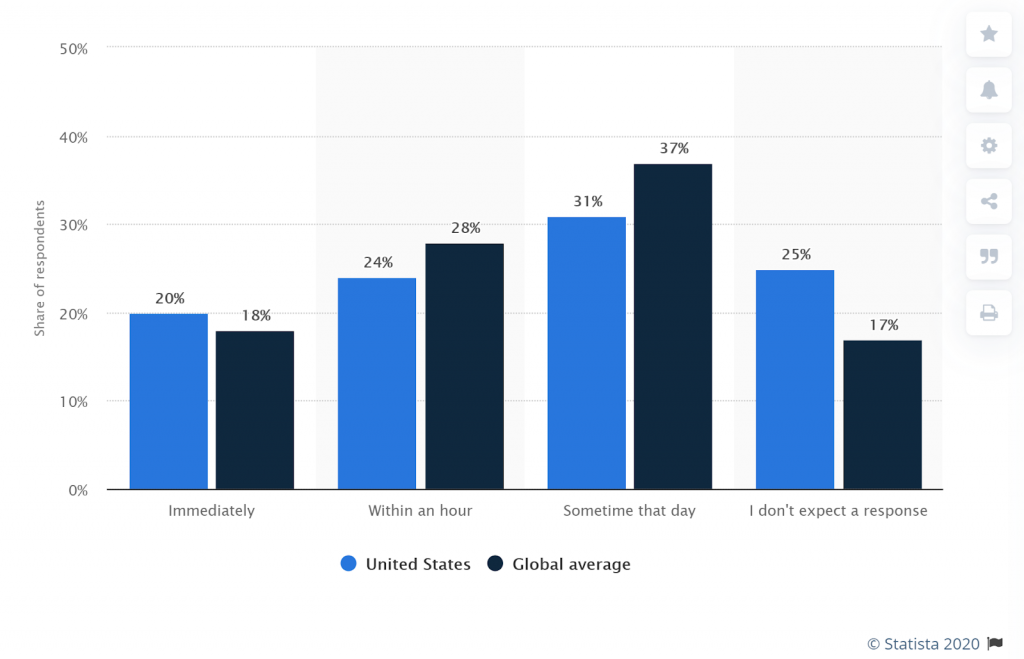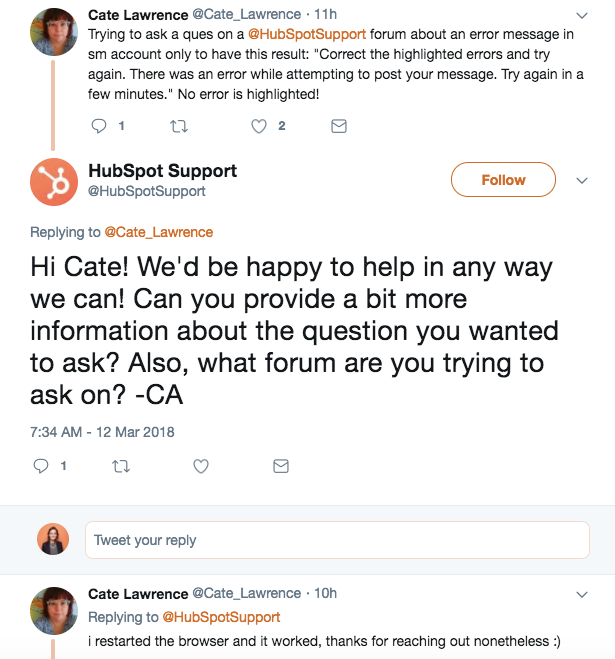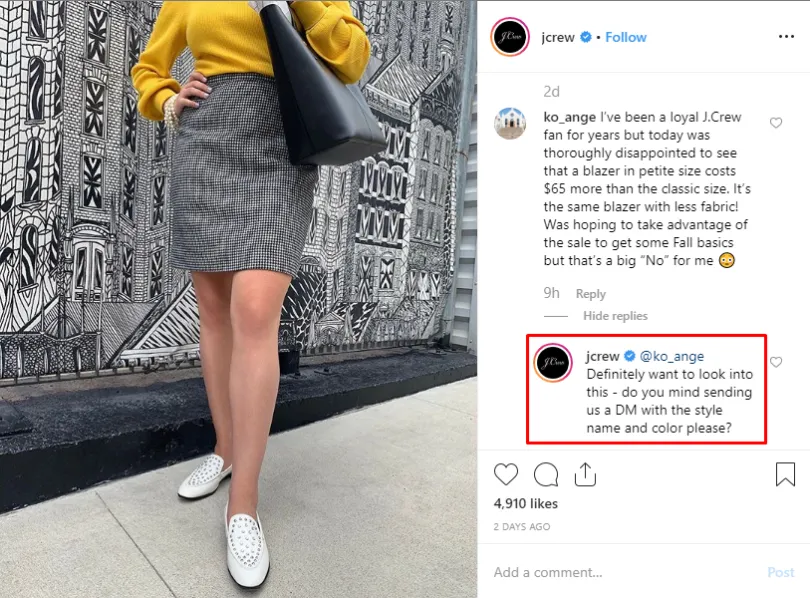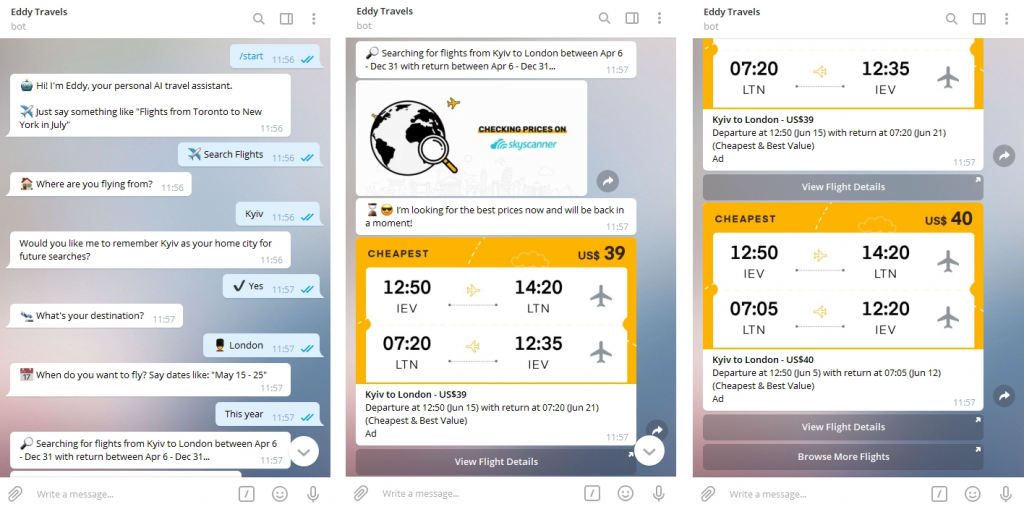To avail the benefits of social media, you must focus on building your online presence and start engaging with your customers today. Companies that were quick to jump on the bandwagon of digitally-powered communication are now seeing mind-blowing results that stemmed from a simple registration on these platforms.
The truth is – the new interactive economy is fully controlled by customers, and you better be a part of it if you don’t want to be put on the back burner.
Need proof? Below are just some of the statistics that will turn any skeptic into a believer.
- 76% of messages businesses receive are addressed to customer service representatives
- 32.3% of those under the age of 25 lists social media as their top priority method of contact
- 96% of consumers confess that customer service plays a big role in establishing their loyalty to a particular brand
As you can tell, customers put a big emphasis on online interactions, and this trend is only going to gain bigger momentum in the upcoming years.
It’s not too late to level up and increase your customer satisfaction across all social media platforms you manage in one place – including Facebook, Instagram, and Twitter among others – in order to build a good reputation for yourself and boost company sales. By enhancing customer satisfaction, you can implement the best practices that will get you closer to becoming your customers’ go-to brand.
1. Adhere to the customer service etiquette
Authenticity is quite frankly the new competitive edge. As more companies are seeking ways to operate from an authentic stance, having social media guidelines in place becomes a non-negotiable. They help define what values your company exhibits and their alignment with how you position the brand on digital platforms.
When deciding what etiquette to adopt, consider the following:
- Response time
- The tone of the voice
- Templates for answering FAQ
- Company-specific hashtags
Social media platforms allow you to showcase your brand from a different perspective. They make it easy to use a friendly tone and appeal to your target audience via engaging social media posts that draw immediate attention and instantly call to action.
Ben&Jerry’s, for instance, chooses the strategy of using the excitement of the changing seasons when engaging with their Instagram followers:

The hip voice they use resonates with their followers who have certain expectations from the brand whose consumers are mainly in the 5 to 35 age range.
2. Respond as quickly as physically possible
As per statista, 37% of customers worldwide expect a response in no more than 24 hours; 28% of them expect it as soon as within an hour of sending the message. This means that you have to satisfy the demand as soon as you can without making the potential customer wait for days on end. In the technologically-advanced era of today, it’s only normal for the bar to be set this high.

The ‘quick-response’ craze has made it mandatory for businesses to reevaluate their approach to customer service. It prompted platforms like Facebook to come up with response rates that would facilitate more efficient communication.
You’ll often notice the company having a ‘typically replies in minutes/within an hour/within a few hours/within a day’ digital badge next to the messenger icon; it gives a pretty good idea of their responsiveness. This also happens to be the indicator that can easily push the customer away if it doesn’t meet his expectations.
Twitter, in this scenario, puts even bigger pressure on businesses that are now held to high expectations. Acting as a short-form blog, it enables everyone to freely express their contentment or, in the majority of the cases, discontentment with the received product/service. So, if you’re planning on growing your customer base on Twitter, keep in mind that people won’t shy away from letting their dissatisfactory feelings known.

3. Monitor social media conversations
Keeping track of communication occurring on social media is no less important than measuring your company’s KPI. It’s the only way to identify whether your social media marketing plan is working, and, if not, find the hands-on solution to fix it. Without adopting some key metrics that are easy to understand, you might end up falling short of providing a satisfactory customer experience.
Check out the most commonly used measurement tools that help understand the efficiency of your customer service on social media:
- Net Promoter Score (NPS): An upgrade from your traditional customer satisfaction score, NPS enables you to establish how likely your customers are to recommend your products or services to a friend or a family member.
- Service-Level Agreement (SLA) Compliance: The speed of your replies can be easily measured via SLA-powered goals you set for your company. It can sound as simple as ‘respond to all Facebook and Instagram messages within an hour’ or involve more complex objectives like tracking the speed with which a particular team member is solving customer queries.
- Inbound volume: To help you keep tabs on the capabilities of your customer service staff, employ the simple act of tracking the number of inquiries you get.
4. Manage your customers’ expectations
To ensure your customers know what to expect, it helps to establish boundaries that will set the tone for the norms your customer service operates under. No two companies can provide the exact same level of service, but they can set the right expectations that will guarantee a minimized number of customer complaints.
Take notes from Amazon Help that clearly stated in their Twitter bio that their support is available in 8 languages 7 days a week. This is a great example of appropriately-set expectations that don’t deceive a customer who, say, has an urgent question in Spanish on a Sunday evening that just can’t wait until Monday.
If, for some reason, you know that there’s no way you’ll be able to respond to every single customer question, consider mentioning a dedicated to queries page on your website customers can access or a (preferably toll-free) phone number they can call in case of an emergency.

5. Learn to handle negative messages with grace
It’s easy to spiral into a defensive mode every time a customer has something negative to say about your company. It seems like not proving that the customer is wrong will inevitably damage your reputation and, as a result, lead to lost revenue.
But this isn’t nearly the case. Showing your human side by handling negativity with positivity has much higher chances of the customer remaining satisfied with the product or the provided service and even recommending it to others. Don’t take our word for it – see it for yourself.

Both HubSpot and KLM addressed the concerns on time and in an apologetic manner which not only added extra points to their karmas but also left customers pleased with the personalized customer support experience.
6. Solve customer problems in private
At times there are types of public customer requests that are better to be taken private. This is primarily true about inquiries that consist of confidential data related to that one customer in particular. In this case, it makes sense to provide him with the lost password or a booking number via private messages that won’t be seen by anyone except for the two of you.
On Instagram, this can be done by posting a comment in response to the customer’s question and informing them that you can further discuss the details via direct messages, also known as DMs.

On Twitter, you could either start the private conversation yourself with a simple click of the “Send a Private Message” button or ask the customer to DM you instead.

No matter what platform you’re using to get back to your customers, remember to always incorporate into your message a friendly opening line, a clear direction to action, and a link to the relevant resource if needed.
7. Implement a chatbot for generic queries
Chatbots are all the rage in the new decade and rightfully so – this AI-powered software enables you to save time on solving the same queries over and over again so that you can focus on more complex inquiries. When installed, they replace the need for a live agent to be on the other side of the screen answering generic questions. Instead, they provide your customers with the information they need in a matter of seconds.

Facebook Messenger and Telegram chatbots are some of the most popular ones that are widely used by businesses from small to big for customer service purposes.
8. Take feedback personally and use it to improve
To thrive in the industry you’re in, you have to be open to customer feedback. This includes both positive and negative opinions that are equally valuable for every business. And even though negative feedback might initially be a hard pill to swallow, it’s the one that will result in the most significant improvements for your brand.
A good way to keep a record of the feedback you get is to create a spreadsheet with two separate columns – complaints and suggestions. Use it to make marketing and sales decisions among others that would align well with customers’ expectations and your business’s ethos.
The takeaway
Social media for customer service isn’t just the future – it’s the present. It’s the tool that allows you to create more intimate relationships with customers by providing them with an inside scoop of what your brand is really about.
Engage with your customers and make them feel heard, and you are guaranteed to establish a like-minded community of people who will stand by your side for years to come. This will be your competitive advantage that won’t permit others to take the spotlight away from you.
Author Bio

Mikkel is passionate about customer experience in every color of the beautiful customer engagement spectrum. He loves building great connections with his customers, which often lead to meaningful friendships that last a lifetime and inspire his work. Driven by the genuine belief that CX is the pivotal force that drives a successful business, he is currently at the helm of Dixa’s customer experience strategy.
